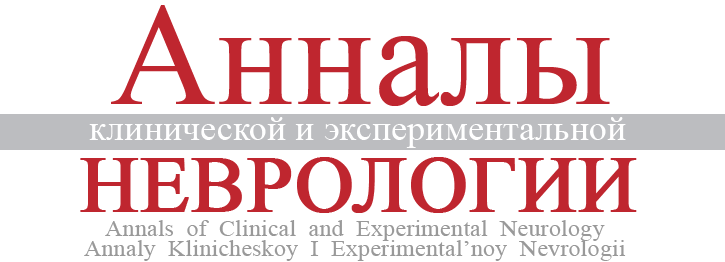Challenges with the differential diagnosis of progressive supranuclear palsy and Parkinson’s disease
- Authors: Magzhanov R.V.1, Davletova A.I.1, Ibatullin R.А.2, Tunik V.F.2, Idrisova R.F.2, Bakhtiyarova K.Z.2
-
Affiliations:
- Bashkir State Medical University
- Kuvatov Republican Clinical Hospital
- Issue: Vol 10, No 4 (2016)
- Pages: 58-61
- Section: Clinical analysis
- Submitted: 30.01.2017
- Published: 02.02.2017
- URL: https://www.annaly-nevrologii.com/journal/pathID/article/view/22
- DOI: https://doi.org/10.17816/psaic22
- ID: 22
Cite item
Full Text
Abstract
Progressive supranuclear palsy (PSP) is a severe old-age neurodegenerative disease that is characterized by pronounced clinical polymorphism and has different phenotypes. Practical differential diagnosis of PSP and Parkinson’s disease (PD) presents significant challenge, especially in onset of the disease. We report an atypical case of PSP characterized by symmetric levodopa-resistant parkinsonian syndrome, early postural instability, supranuclear oculomotor disorders (vertical gaze palsy), MR signs of midbrain atrophy, and a number of overlapping clinical symptoms similar with the manifestations of PD. A detailed algorithm of differential diagnosis of PSP and PD as well as a more adequate diagnostic formulation are proposed for this and similar cases of neurodegenerative pathology.
About the authors
R. V. Magzhanov
Bashkir State Medical University
Email: angelika7d@mail.ru
Russian Federation, Ufa
Angelika I. Davletova
Bashkir State Medical University
Author for correspondence.
Email: angelika7d@mail.ru
Russian Federation, Ufa
R. А. Ibatullin
Kuvatov Republican Clinical Hospital
Email: angelika7d@mail.ru
Russian Federation, Ufa
V. F. Tunik
Kuvatov Republican Clinical Hospital
Email: angelika7d@mail.ru
Russian Federation, Ufa
R. F. Idrisova
Kuvatov Republican Clinical Hospital
Email: angelika7d@mail.ru
Russian Federation, Ufa
K. Z. Bakhtiyarova
Kuvatov Republican Clinical Hospital
Email: angelika7d@mail.ru
Russian Federation, Ufa
References
- Ivanova-Smolenskaja I.A., Markova E.D., Illarioshkin S.N., Nikol’skaja N.N. [Monogenic hereditary diseases of the central nervous system] In.: Ju.E. Vel’tishheva, P.A. Temina (eds.) Nasledstvennye bolezni nervnoj sistemy [Hereditary diseases of the nervous system]. Moscow. Medicina Publ., 1998: 9–104. (In Russ.).
- Periquet M., Lucking C., Vaughan J. et al. Origin of the mutations in the PARKIN gene in Europe: exon rearrangements are independent recurrent events, whereas point mutations may result from founder effects. Am. J. Hum. Genet. 2001; 68: 617–26. doi: 10.1086/318791. PMID: 11179010.
- Illarioshkin S.N. DNK-diagnostika i mediko-geneticheskoe konsul’tirovanie [DNA-diagnostics and medical-genetic counseling]. Moscow. MIA Publ., 2004. (in Russ.).
- Artem’ev D.V., Golubev V.L., Jahno N.N. [Progressive supranuclear palsy]. In.: N.N. Jahno (ed.) Bolezni nervnoj sistemy [Diseases of the nervous system], V. 2. Moscow. Medicina Publ., 2007: 96–100. (in Russ.).
- Shtok V.N., Levin O.S., Fedorova N.V. Ekstrapiramidnyye rasstroystva [Extrapyramidal disorders]. Moscow. MIA Publ., 2002. (in Russ.).
- Colosimo C., Riley D.E., Wenning G.K. Handbook of atypical parkinsonism. NY: Cambridge University Press, 2011. doi: 10.1017/CBO9780511920936.
- Dickson D.W., Rademakers R., Hutton M.L. Progressive supranuclear palsy: pathology and genetics. Brain Pathol. 2007; 17: 74–82. doi: 10.1111/j.1750-3639.2007.00054.x. PMID: 17493041.
- Wakabayashi K., Takahashi H. Pathological heterogeneity in progressive supranuclear palsy and corticobasal degeneration. Neuropathology 2004; 24: 79–86. doi: 10.1111/j.1440-1789.2003.00543.x. PMID: 15068177.
- Ludolph A.C., Kassubek J., Landwehrmeyer B.G. et al. Tauopathies with parkinsonism: clinical spectrum, neuropathologic basis, biological markers and treatment options. Eur. J. Neurol. 2009; 16: 297–309. doi: 10.1111/j.1468-1331.2008.02513.x. PMID: 19364361.
- Williams D.R., Lees A.J. Progressive supranuclear palsy: clinicopathological concepts and diagnostic challenges. Lancet Neurol. 2009;8: 270–279. doi: 10.1016/S1474-4422(09)70042-0. PMID: 19233037.
- Litvan I., Agid Y., Calne D. et al. Clinical research criteria for the diagnosis of progressive supranuclear palsy (Steele–Richardson–Olszewski syndrome): report of the NINDS-SPSP international workshop. Neurology 1996; 47: 1–9. PMID: 8710059.
- Levin O.S., Fedorova N.V. Bolezn’ Parkinsona [Parkinson’s disease]. Moscow.: MEDpress-inform Publ., 2014. (in Russ.).
- Williams D.R., Lees A.J. What features improve the accuracy of the clinical diagnosis of progressive supranuclear palsy-parkinsonism (PSP-P)? Mov. Disord. 2010; 25: 357–362. doi: 10.1002/mds.22977. PMID: 20108379.
- Lopez G., Bayulkem K., Hallett M. Progressive supranuclear palsy (PSP): Richardson syndrome and other PSP variants. ActaNeuro. l Scand. 2016; 134: 242–249. doi: 10.1111/ane.12546. PMID: 27070344.
- Gibb W.R., Lees A.J. The relevance of the Lewy body to the pathogenesis of idiopathic Parkinson’s disease. J. Neurol. Neurosurg. Psychiatry. 1988; 51: 745–752. doi: 10.1136/jnnp.51.6.745. PMID: 2841426.
- Fedotova E.Ju., Chechetkin A.O., Ivanova-Smolenskaja I.A., Illarioshkin S.N. [The case of progressive supranuclear palsy with corticobasal syndrome]. Nervnye bolezni. 2009; 2: 38–43. (in Russ.).
Supplementary files








